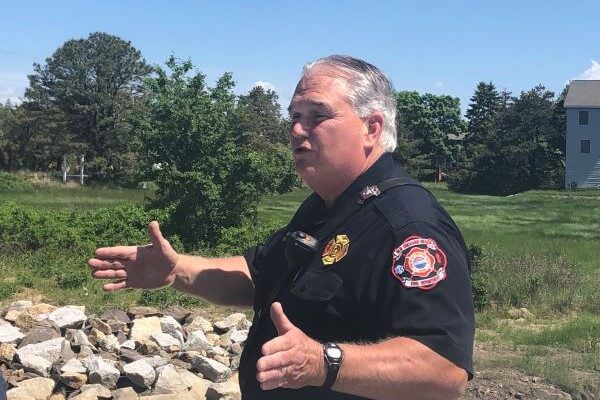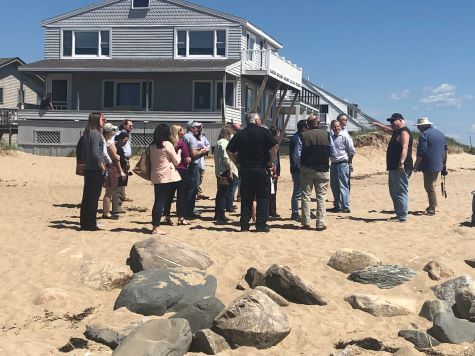Infrastructure Rebuilding and Resiliency Commission meets in Old Orchard Beach
 |
|
Old Orchard Beach Fire Chief John Gilboy talks about storm damage at New Salt Road in Ocean Park on Friday morning. PHOTO BY LIZ GOTTHELF
|
Communities across Maine need to look at storm mitigation solutions that can sustain them well into the future, and not just rebuild to get them through to the next storm.
That was the overwhelming message Friday morning at a meeting of the newly formed Infrastructure Rebuilding and Resilience Commission at the Old Orchard Beach Fire Station, attended by state officials as well as local officials from communities across York County.
The Infrastructure Rebuilding and Resilience Commission was established May 21 by Governor Janet Mills to develop the state’s first plan for long-term infrastructure resilience. The creation of the commission comes in the wake of two devastating back-to-back storms in January that warranted a federal disaster declaration.
Friday morning’s meeting was the second stop in a listening tour the commission has embarked on to learn the challenges communities face after storms.
“This is a commission that has started on a run and we are only increasing our speed. We have a lot of territory to cover over the next few months,” said Dan Tishman, co-chair of the commission.
January’s storms are likely not the last events of this kind the state will see, and officials need to be prepared to respond to them and “not just assume we’re going to put things back the way they were in the past,” he said.
Megan Arsenault, deputy director of York County Emergency Management Agency showed slides of areas in York County after the Jan 10 and 13 storms, showing structural damage on homes, flooding in streets and flooding in basements.
“Seeing these pictures again was traumatizing. I’ve never, ever seen anything like this before in my life,” said District 131 State Rep. Lori Gramlich.
Gramlich is also the director of the Ocean Park Association. She said the association’s buildings suffered nearly $300,000 in damage after the January storms and did not have flood insurance. The association has applied for public assistance and hoping to get reimbursed for some of its expense, said Gramlich. Many people in Ocean Park also did not have flood insurance as they had never before seen flooding of this magnitude, she said.
Gramlich said sand dunes are becoming more critical in protecting the shoreline, and she continues to work on legislation that will help the shoreline become more resilient, including LD 2030, which eases the permitting process on raising heights of wharfs, docks and piers.
Old Orchard Beach Town Manager Diana Asanza said the town was still recovering from the impacts of the back-to-back storms in January. She said many businesses rely on 14 to 16 weeks in the summer when people come to visit the town and its long stretch of beach.
“One of the most important economic drivers for this town is our beach,” said Asanza.
She said the town has lost five feet of sand near The Pier, the busiest area of the beach. Low tide now looks like what high tide used to look like, she said. With the loss of sand dunes, there is also less piping plover activity this year, she said.
Though much of the dune grass was destroyed in the storm, the dunes did their job to protect shoreline properties, said Asanza.
She said the town needs help with rebuilding the dunes, to protect the shoreline against future storms. Asanza also said the new county-wide dredge machine will also help, but communities are going to need assistance with costs and permitting.
Old Orchard Beach Fire Chief John Gilboy recalled January storm events - using a boat and a front-end loader to rescue people from their homes in the coastal community of Ocean Park and calling Central Maine Power to turn off power in the area. He said crews waded through waist deep waters to get to a garage fire, and at one point, he stepped off the front-end loader that was traveling through the streets of Ocean Park and discovered the water was over his head.
He said with heavy rains and high tides in the storm mix, there was a short window of time for people to leave the area after the storm began. Many people, even though they had been urged by the town prior to the storm to leave, opted to stay in their homes, a decision they regretted later when they needed to be rescued. Mutual aid partners were unable to help because they were unable to travel through the area.
State Senator Donna Bailey of Saco said she is working ways to make flood insurance more accessible, as many say that it is not affordable and does not cover enough.
She said municipalities need to work with state, county and federal governments, but they also need to work with private property owners.
“They are on the front lines here. And if we assist them in building back better and more resilient, we are also protecting the community behind those property owners,” she said.
Laurie Smith, town manager of Kennebunkport, said the town has raised roadways up to four feet, a complex process that requires working with abutting properties. She said the town could also benefit from storm water upgrades. There needs to be help from the state, she said, for solutions that are not just short-term fixes.
“Every time we talk about these things, I say, ‘for how long,” she said.
Saco Public Works Director Patrick Fox said the city is currently working on a beach management plan.
Tishman said that communities had gone to “herculean levels” after the storms to get to where they were today.
He said the response is often to rebuild as quickly as possible, but that is not always the best long-term solution. He said communities needed to get technical engineering assistance to make sure recovery efforts were lasting solutions and not just feel-good measures.
“What’s the 100-year fix, rather than the let’s get it done today,” said Tishman.
Gramlich said there’s not one sole solution.
“I think we need to look at this in the aggregate and in the bigger picture, relative to what are the tools that we have in our collective toolboxes so that we can have solutions that are going to fit the whole coastal community,” she said.
 |
State and municipal officials discuss storm damage at the beach in Ocean Park on Friday. PHOTO BY LIZ GOTTHELF |
After the meeting, commission members and other attendees toured areas along the coast in Old Orchard Beach and Saco that were impacted by the January storms.
Saco Bay News Publisher Liz Gotthelf can be reached at newsdesk@sacobaynews.com.

